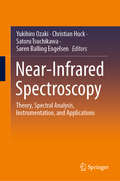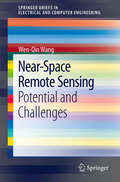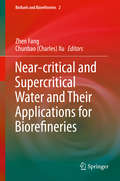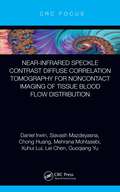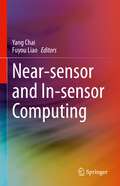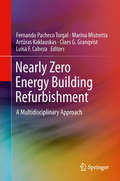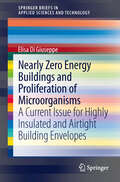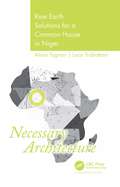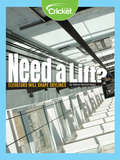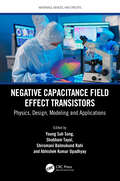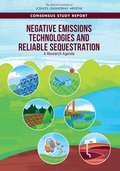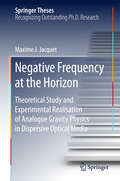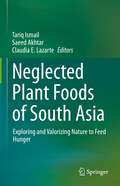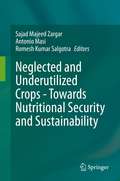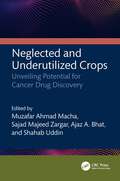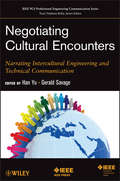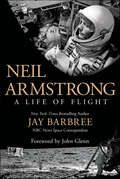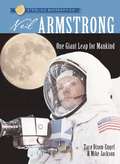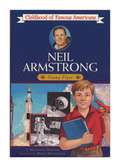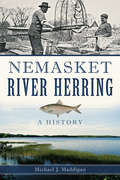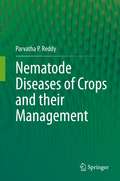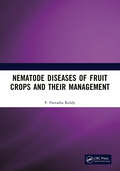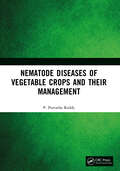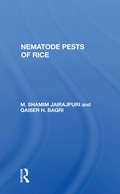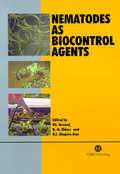- Table View
- List View
Near-Infrared Spectroscopy: Theory, Spectral Analysis, Instrumentation, and Applications
by Yukihiro Ozaki Christian Huck Satoru Tsuchikawa Søren Balling EngelsenThis book provides knowledge of the basic theory, spectral analysis methods, chemometrics, instrumentation, and applications of near-infrared (NIR) spectroscopy—not as a handbook but rather as a sourcebook of NIR spectroscopy. Thus, some emphasis is placed on the description of basic knowledge that is important in learning and using NIR spectroscopy. The book also deals with applications for a variety of research fields that are very useful for a wide range of readers from graduate students to scientists and engineers in both academia and industry. For readers who are novices in NIR spectroscopy, this book provides a good introduction, and for those who already are familiar with the field it affords an excellent means of strengthening their knowledge about NIR spectroscopy and keeping abreast of recent developments.
Near-Space Remote Sensing
by Wen-Qin WangNear-space is defined as the atmospheric region from about 20 kilometer (km) altitude to 100 km altitude above the Earth's surface. It has received much attention in recent years and several types of near-space vehicles are currently being studied, developed, or employed. "Near-Space Remote Sensing: Potential and Challenges" concentrates mainly on the role of near-space vehicles in bridging the gap between satellites and airplanes for microwave remote sensing applications, providing a top-level system description and aiming to encourage further research. Further, this book also describes several potential applications such as passive surveillance, reconnaissance, and high resolution wide swath remote imaging. The book is intended for geographers, transportation engineers and other researchers involved in remote sensing development and applications, in particular for near-space vehicles. Wen-Qin Wang is an assistant professor at the School of Communication and Information Engineering, University of Electronic Science and Technology of China.
Near-critical and Supercritical Water and Their Applications for Biorefineries
by Zhen Fang Chunbao Charles XuThe book provides fundamental chemistry and properties of near-critical water (NCW) and supercritical water (SCW), criteria and challenges/solutions in reactor design for NCW and SCW processes, and up-to-date reviews and practice of a wide range of their applications in bio refineries including: production of hydrochars from biomass, SCW oxidation (SCWO) for waste treatment, SCW gasification (SCWG) of biomass and waste for hydrogen and methane production, hydrothermal liquefaction of biomass, production of chemicals and SCWO of biofuels for energy. It also presents techno-economic analysis of hydrogen production via SCWG of biomass. The book will be highly essential for both academic researchers and industrial practitioners for developing novel bio refinery technologies and processes employing NCW or SCW for treatment of various organic waste streams and production of bio-energy and bio-based chemicals from bio-renewable resources. Prof. Dr. Zhen Fang is leader and founder of biomass group, Xishuangbanna Tropical Botanical Garden, Chinese Academy of Sciences, China. Dr Chunbao (Charles) Xu is currently an Associate Professor of Chemical Engineering and NSERC/FP Innovations Industrial Research Chair in Forest Bio refinery at Western University, Canada.
Near-infrared Speckle Contrast Diffuse Correlation Tomography for Noncontact Imaging of Tissue Blood Flow Distribution
by Lei Chen Daniel Irwin Siavash Mazdeyasna Chong Huang Mehrana Mohtasebi Xuhui Lui Guoqiang YuImaging of tissue blood flow (BF) distributions provides vital information for the diagnosis and therapeutic monitoring of various vascular diseases. The innovative near-infrared speckle contrast diffuse correlation tomography (scDCT) technique produces full 3D BF distributions. Many advanced features are provided over competing technologies including high sampling density, fast data acquisition, noninvasiveness, noncontact, affordability, portability, and translatability across varied subject sizes. The basic principle, instrumentation, and data analysis algorithms are presented in detail. The extensive applications are summarized such as imaging of cerebral BF (CBF) in mice, rat, and piglet animals with skull penetration into deep brain. Clinical human testing results are described by recovery of BF distributions on preterm infants (CBF) through incubator wall, and on sensitive burn tissues and mastectomy skin flaps without direct device-tissue interactions. Supporting activities outlined include integrated capability for acquiring surface curvature information, rapid 2D blood flow mapping, and optimizations via tissue-like phantoms and computer simulations. These applications and activities both highlight and guide the reader as to the expected abilities and limitations of scDCT for adapting into their own preclinical/clinical research, use in constrained environments (i.e., neonatal intensive care unit bedside), and use on vulnerable subjects and measurement sites.
Near-sensor and In-sensor Computing
by Yang Chai Fuyou LiaoThis book provides a detailed introduction to near-sensor and in-sensor computing paradigms, their working mechanisms, development trends and future directions. The authors also provide a comprehensive review of current progress in this area, analyze existing challenges in the field, and offer possible solutions. Readers will benefit from the discussion of computing approaches that intervene in the vicinity of or inside sensory networks to help process data more efficiently, decreasing power consumption and reducing the transfer of redundant data between sensing and processing units.Provides readers with a detailed introduction to the near-sensor and in-sensor computing paradigms;Includes in-depth and comprehensive summaries of the state-of-the-art development in this field;Discusses and compares various neuromorphic sensors and neural networks:Describes integration technology for near-/in-sensor computing;Reveals the relationship between near-/in-sensor computing and other computing paradigms, such as neuromorphic computing, edge computing, intuitive computing, and in-memory computing.
Nearly Zero Energy Building Refurbishment
by Fernando Pacheco Torgal Marina Mistretta Artūras Kaklauskas Claes G. Granqvist Luisa F. CabezaThe recast of the Energy Performance of Buildings Directive (EPBD) was adopted by the European Parliament and the Council of the European Union on 19 May 2010. For new buildings, the recast fixes 2020 as the deadline for all new buildings to be "nearly zero energy" (and even sooner for public buildings - by the end of 2018). This book gives practitioner an important tool to tackle the challenges of building refurbishment towards nearly zero energy. This book is welcome at this time and sets the scene for professionals whether practitioners or researchers to learn more about how we can make whether old or new buildings more efficient and effective in terms of energy performance.
Nearly Zero Energy Buildings and Proliferation of Microorganisms
by Elisa Di GiuseppeThis book provides a concise review of the thermo-physical phenomena which regulate heat and moisture transportation in Nearly Zero Energy Buildings envelopes, and their relationship with the growth of biological organisms. It describes the main microorganisms proliferating on contemporary building elements and within buildings. It also states the consequences of biological growth on durability, aesthetics and human health; and provides the main methods for the analytical and experimental evaluation of proliferation. Finally, through the review of recent developments, remedial actions to counter the biological phenomenon are examined, and an outline is provided for future innovations in a field not yet widely investigated.
Necessary Architecture: Raw Earth Solutions for a Common House in Niger
by Alisia Tognon Luca TrabattoniNiger is sand, light, and heat. Starting from the necessity of the Mission Catholique du Dosso, which has worked in Niger for several years, this book speaks about the Nigerien situation which is characterized by a countrywide spread of poverty. Along with studying the country’s environmental, geographical conditions, the book discusses raw earth architecture in both vernacular and contemporary contexts. A number of the most common techniques are described. The possibilities for these methods to adapt to the contemporary language of architecture without losing the technical and physical benefits inherent in them are illustrated. The book embraces some topics that are not common but highly relevant in the Developing World, such as identity through the evolution of architecture and the value of transmitting knowledge related to the vernacular building process. Nowadays, Niger’s condition is characterized by a lack of resources, both physical and cultural. Earthen technology appears to be a valid solution in this situation for the creation of an environmentally sustainable approach. The book aims to provide an overview of the possibility of constructing new buildings related to the climate and traditional context, applying vernacular technology and solutions in a contemporary application. Providing a balance between teaching vernacular knowledge and the contemporary architectural language could help face this out-of-resource situation, aiming to get comfortable and affordable living spaces.
Need a Lift?
by Maria Parrott-RyanBig cities will soon boast supertall and megatall skyscrapers. This means we’ll need elevators that can safely handle them! Engineers are busy rising to the challenge of designing high tech elevators to help people reach these new heights.
Negative Capacitance Field Effect Transistors: Physics, Design, Modeling and Applications (Materials, Devices, and Circuits)
by Shubham Tayal Shiromani Balmukund Rahi Abhishek Kumar Upadhyay Young Suh SongThis book aims to provide information in the ever-growing field of low-power electronic devices and their applications in portable devices, wireless communication, sensor, and circuit domains. Negative Capacitance Field Effect Transistors: Physics, Design, Modeling and Applications discusses low-power semiconductor technology and addresses state-of-the-art techniques such as negative capacitance field effect transistors and tunnel field effect transistors. The book is split into three parts. The first part discusses the foundations of low-power electronics, including the challenges and demands and concepts such as subthreshold swing. The second part discusses the basic operations of negative capacitance field effect transistors (NCFETs) and tunnel field effect transistors (TFETs). The third part covers industrial applications including cryogenics and biosensors with NC-FET. This book is designed to be a one-stop guide for students and academic researchers, to understand recent trends in the IT industry and semiconductor industry. It will also be of interest to researchers in the field of nanodevices such as NC-FET, FinFET, tunnel FET, and device–circuit codesign.
Negative Emissions Technologies and Reliable Sequestration: A Research Agenda
by Engineering Medicine National Academies of SciencesTo achieve goals for climate and economic growth, “negative emissions technologies” (NETs) that remove and sequester carbon dioxide from the air will need to play a significant role in mitigating climate change. Unlike carbon capture and storage technologies that remove carbon dioxide emissions directly from large point sources such as coal power plants, NETs remove carbon dioxide directly from the atmosphere or enhance natural carbon sinks. Storing the carbon dioxide from NETs has the same impact on the atmosphere and climate as simultaneously preventing an equal amount of carbon dioxide from being emitted. Recent analyses found that deploying NETs may be less expensive and less disruptive than reducing some emissions, such as a substantial portion of agricultural and land-use emissions and some transportation emissions. In 2015, the National Academies published Climate Intervention: Carbon Dioxide Removal and Reliable Sequestration, which described and initially assessed NETs and sequestration technologies. This report acknowledged the relative paucity of research on NETs and recommended development of a research agenda that covers all aspects of NETs from fundamental science to full-scale deployment. To address this need, Negative Emissions Technologies and Reliable Sequestration: A Research Agenda assesses the benefits, risks, and “sustainable scale potential” for NETs and sequestration. This report also defines the essential components of a research and development program, including its estimated costs and potential impact.
Negative Frequency at the Horizon: Theoretical Study And Experimental Realisation Of Analogue Gravity Physics In Dispersive Optical Media (Springer Theses)
by Maxime J. JacquetThis book is part of a large and growing body of work on the observation of analogue gravity effects, such as Hawking radiation, in laboratory systems. The book is highly didactic, skillfully navigating between concepts ranging from quantum field theory on curved space-times, nonlinear fibre optics and the theoretical and experimental foundations in the physics of optical analogues to the Event Horizon. It presents a comprehensive field-theoretical framework for these systems, including the kinematics governing the fields. This allows an analytical calculation of the all-important conversion of vacuum fluctuations into Hawking radiation. Based on this, emission spectra are computed, providing unique insights into the emissions from a highly dispersive system. In an experimental part, the book develops a clear and systematic way to experimentally approach the problem and demonstrates the construction of an experimental setup and measurements of unprecedented sensitivity in the search for stimulation of the Hawking effect.
Neglected Plant Foods Of South Asia: Exploring and valorizing nature to feed hunger
by Tariq Ismail Saeed Akhtar Claudia E. LazarteAccording to the global hunger index, South Asia has worldwide highest rate of undernourished people. Such a burden of food insecurity and various forms of malnutrition are directly associated with the existing food production system that ignores biodiversity, food affordability, and sustainability. During the last five decades, food production system has witnessed a global shift from ethnic to mainstream staple cereals production and promotion. Such an approach has badly affected the regional genetic pool of a diverse range of nourishing, economical, and sustainable edible plant species which are now referred to as neglected or underutilized food crops. Neglected Plant Foods of South Asia collects and preserves existing knowledge of underutilized, minor, wild, neglected and traditional food plants of South Asia, and their utilization for the production of value-added food products. Aiming at introducing plant – based food solutions to address the increasing burden of food insecurity among marginalized communities of South Asia, this manuscript covers a plethora of nutrient-dense plant species including fruits, vegetables, roots, tubers, cereals, pseudo-cereals, and pulses. In addition to having an overview of each plant's origin, cultivation practices and production statistics, researchers will find comprehensive information on nutritional composition, food manufacturing properties, value-addition and traditional uses of neglected plant foods. Recent updates on strategies to combat toxicological risks associated with the consumption of neglected food plants have also been included. With this volume, researchers will have complete information on neglected, underutilized traditional edible plants of South Asia, and their potential to increase food security under the emerging challenges of climate change.
Neglected and Underutilized Crops - Towards Nutritional Security and Sustainability
by Romesh Kumar Salgotra Antonio Masi Sajad Majeed ZargarThis book covers important topics on various neglected and underutilised crops (vegetables, cereals, fruit crops). It gives an overview of the potential, availability of genetic and genomic resources, and the future prospects of these food crops. The book presents different chapters on the importance of underutilised crops with respect to sustainable agriculture and describes the approaches that must be followed for improving the yield and production of these crops. It covers a wide range of food crops such as millet, buckwheat, underutilised spices, underutilised vegetables and underutilised fruit crops. It also provides insights on what smart foods are? And, whether these neglected crops qualify as smart foods?This up-to-date and informative book is meant for food scientists, geneticists, breeders and biotechnologists. It is of interest to students, researchers and course instructors in these fields.
Neglected and Underutilized Crops: Unveiling Potential for Cancer Drug Discovery
by Sajad Majeed Zargar Muzafar Ahmad Macha Ajaz A. Bhat Shahab UddinThis book provides a comprehensive review of the potential of neglected and underutilized crops in the prevention and treatment of various cancers. It explores various aspects of these crops and their bioactive compounds, shedding light on their role in health and nutrition. The initial chapters discuss neglected and underutilized crops, emphasizing their relevance in human disease and cancer management. These chapters also examine the bioavailability and formulation strategies of bioactive compounds derived from these crops. The book further delves into the isolation, availability, and therapeutic uses of these bioactive compounds, emphasizing their significant role in modern medicine. It also reviews the potential of the Indian gooseberry, quinoa, and seabuckthorn in cancer treatment and management. Additionally, the book discusses neglected medicinal plants of the Northwestern Himalayas, showcasing their potential applications in both traditional and modern medicine. It also highlights the importance of sustainable cultivation and conservation efforts to ensure the long-term availability of these crops. This book is of particular interest to scientists, researchers, and academics in fields such as agriculture, biochemistry, nutrition, and medicine.
Negotiating Cultural Encounters: Narrating Intercultural Engineering and Technical Communication, 1st Edition
by Han Yu Gerald SavageDiscusses the challenges of intercultural communication in engineering, technical, and related professional fields Given today's globalized technical and engineering environment, intercultural communication is an essential topic for engineers, other technical professionals, and technical communicators to learn. Engineering programs, in particular, need to think about how to address the ABET requirement for students to develop global competence and communication skills. This book will help readers learn what intercultural communication is like in the workplace--which is an important first step in gaining intercultural competence. Through narratives based on the real experiences of working professionals, Negotiating Cultural Encounters: Narrating Intercultural Engineering and Technical Communication covers a range of design, development, research, and documentation projects--offering an authentic picture of today's international workplace. Narrative contributors present firsthand experience and perspectives on the complexities and challenges of working with multicultural team members, international vendors, and diverse customers; additional suggested readings and discussion questions provide students with information on relevant cultural factors and invite them to think deeply and critically about the narratives. This collection of narratives: Responds to the need for updated firsthand information in intercultural communication and will help us prepare workplace professionals Covers various topics such as designing e-commerce websites, localizing technical documentation, and translating workplace safety materials Provides hands-on studies of intercultural professional communication in the workplace Is targeted toward institutions that train engineers for technical communication tasks in diverse sociocultural environments Presents contributions from a diverse group of professionals Recommends additional material for further pursuit A book unlike any other in its field, Negotiating Cultural Encounters is ideal for all engineering and technical communication professionals seeking to better communicate their ideas and thoughts in the multicultural workplaces of the world.
Neil Armstrong: A Life of Flight
by Jan BarbreeMuch has been written about Neil Armstrong, America's modern hero and history's most famous space traveler. Yet shy of fame and never one to steal the spotlight Armstrong was always reluctant to discuss his personal side of events. Here for the first time is the definitive story of Neil's life of flight he shared for five decades with a trusted friend – Jay Barbree.Working from 50 years of conversations he had with Neil, from notes, interviews, NASA spaceflight transcripts, and remembrances of those Armstrong trusted, Barbree writes about Neil's three passions – flight, family, and friends. This is the inside story of Neil Armstrong from the time he flew combat missions in the Korean War and then flew a rocket plane called the X-15 to the edge of space, to when he saved his Gemini 8 by flying the first emergency return from Earth orbit and then flew Apollo-Eleven to the moon's Sea of Tranquility. Together Neil and Jay discussed everything, from his love of flying, to the war years, and of course his time in space. The book is full of never-before-seen photos and personal details written down for the first time, including what Armstrong really felt when he took that first step on the moon, what life in NASA was like, his relationships with the other astronauts, and what he felt the future of space exploration should be.As the only reporter to have covered all 166 American astronaut flights and moon landings Jay knows these events intimately. Neil Armstrong himself said, "Barbree is history's most experienced space journalist. He is exceptionally well qualified to recall and write the events and emotions of our time." Through his friendship with Neil and his dedicated research, Barbree brings us the most accurate account of his friend's life of flight, the book he planned for twenty years.
Neil Armstrong: One Giant Leap for Mankind (Sterling Biographies)
by Mike Jackson Tara Dixon EngelEven at an age when other boys were just learning to drive, Neil was training to reach the skies. He went on to study aeronautical engineering, win medals as a fighter pilot, try out the X-15 experimental rocket plane, and become one of the elite few chosen to be a NASA astronaut…where he took the test pilot’s credo of “higher, faster and farther” to thrilling heights.
Neil Armstrong: Young Flyer
by Meryl Henderson Montrew DunhamRich or poor, great American men and women lived out childhoods as vastly different as the adults they became. Here young readers will learn about the early years of the first person to step foot on the moon, a historic feat he described as "one small step for man, one giant leap for mankind."
Nemasket River Herring: A History (Natural History)
by Michael J. MaddiganEvery spring, the Nemasket River welcomes thousands of migratory river herring that thrash and leap as they fight their way upstream from Mount Hope Bay. Of all non-domesticated animals, the river herring--or alewife--has arguably had the greatest impact on the towns along the river in southeastern Massachusetts. The area was called "Nemasket," or "place of fish," by Native Americans, and its earliest English colonists were dependent on river herring for their very survival. They provided a livelihood for generations of families in Middleborough and Lakeville, shaping their culture and the course of the region's development. Today, herring fishing is banned, and the community is working toward protecting and preserving the river so the herring have a place to return each year. Join historian Michael J. Maddigan as he explores the big story of the small fish that shaped life along the Nemasket River.
Nematode Diseases of Crops and their Management
by Parvatha P. ReddyThis edited book provides knowledge about hemicelluloses biorefinery approaching production life cycle, circular economy, and valorization by obtaining value-added bioproducts and bioenergy. A special focus is dedicated to chemical and biochemical compounds produced from the hemicelluloses derivatives platform. Hemicelluloses are polysaccharides located into plant cell wall, with diverse chemical structures and properties. It is the second most spread organic polymer on nature and found in vast lignocellulosic materials from agro and industrial wastes, therefore, hemicelluloses are considered as abundant and renewable raw material/feedstock. Biorefinery concept contributes to hemicelluloses production associated with biomass industrial processes. Hemicelluloses are alternative sources of sugars for renewable fuels and as platform for chemicals production. This book reviews chemical processes for sugar production and degradation, obtaining of intermediate and final products, and challenges for pentose fermentation. Aspects of hemicelluloses chain chemical and enzymatic modifications are presented with focus on physicochemical properties improvement for bioplastic and biomaterial approaches. Hemicelluloses are presented as sources for advanced materials in biomedical and pharmaceutical uses, and as hydrogel for chemical and medicine deliveries. An interdisciplinary approach is needed to cover all the processes involving hemicelluloses, its conversion into final and intermediate value-added compounds, and bioenergy production. Covering this context, this book is of interest to teachers, students, researchers, and scientists dedicated to biomass valorization. This book is a knowledge source of basic aspects to advanced processing and application for graduate students, particularly. Besides, the book serves as additional reading material for undergraduate students (from different courses) with a deep interest in biomass and waste conversion, valorization, and chemical products from hemicelluloses.
Nematode Diseases of Fruit Crops and their Management
by P. Parvatha ReddySplit into six sections, this book collates information on the various aspects of nematode diseases of fruit crops and their management. The subject matter in this book discusses: International and Indian fruit crop scenario, food and nutritional security, bridging yield gap, and techniques to enhance productivity. Different aspects of nematode diseases in fruit crops such as economic importance, emerging nematode problems, interaction with other pathogens, and nematode management methods. Nematode diseases of tropical, sub-tropical, temperate, and semi-arid fruit crops and their management. The vision for the future including current nematode management strategies, new paradigms for nematode management, transfer of technology, future approaches, and conclusions. This book is aimed at policy makers, practicing farmers, and scientists involved in teaching, research and extension activities related to fruit crop nematodes and their management.Print edition not for sale in India.
Nematode Diseases of Vegetable Crops and their Management
by P. Parvatha ReddyThis book collates information on the various aspects of nematode diseases in vegetable crops and their management. The subject matter in this book discusses: Vegetable crop area, technological interventions to enhance productivity, post-harvest treatments, and integrated pest management. Different aspects of nematode diseases such as economic importance, emerging nematode problems, and major nematode pests and their interaction with other pathogens such as fungi, bacteria, and viruses). Regulatory, physical, cultural, chemical, biological, host resistance and integrated nematode management methods. Nematode diseases of mushrooms, root and leafy vegetables, and solanaceous, leguminous, cruciferous, cucurbitaceous, malvaceous and malvaceous crops. The vision for the future including integrated nematode management, pillars of INM, modifications and expansions to INM, new building blocks of INM, and conclusions. This book is aimed at policy makers, practicing farmers, and scientists involved in teaching, research and extension activities related to vegetable crop nematodes and their management.Print edition not for sale in India.
Nematode Pests Of Rice
by M. Shamim JairajpuriThe triple alliance of pests, pathogens and weeds takes a heavy toll on the yield of rice. Nematodes in particular can cause considerable damage and also present great difficulties in their eradication. Because of difficulties in identification, many nematode pests of rice had gone unnoticed in the past. It is in this context that the present book
Nematodes as Biocontrol Agents
by Parwinder S. Grewal Ralf-Udo Ehlers David I. Shapiro-IlanThis book aims to document and illustrate the major developments in the use of nematodes for biological control of insects and slugs. It has three major sections covering entomopathogenic nematodes, entomophilic nematodes, and slug-parasitic nematodes. Each of these sections discusses biology, commercial production, formulation and quality control, application technology, strategy and safety.
